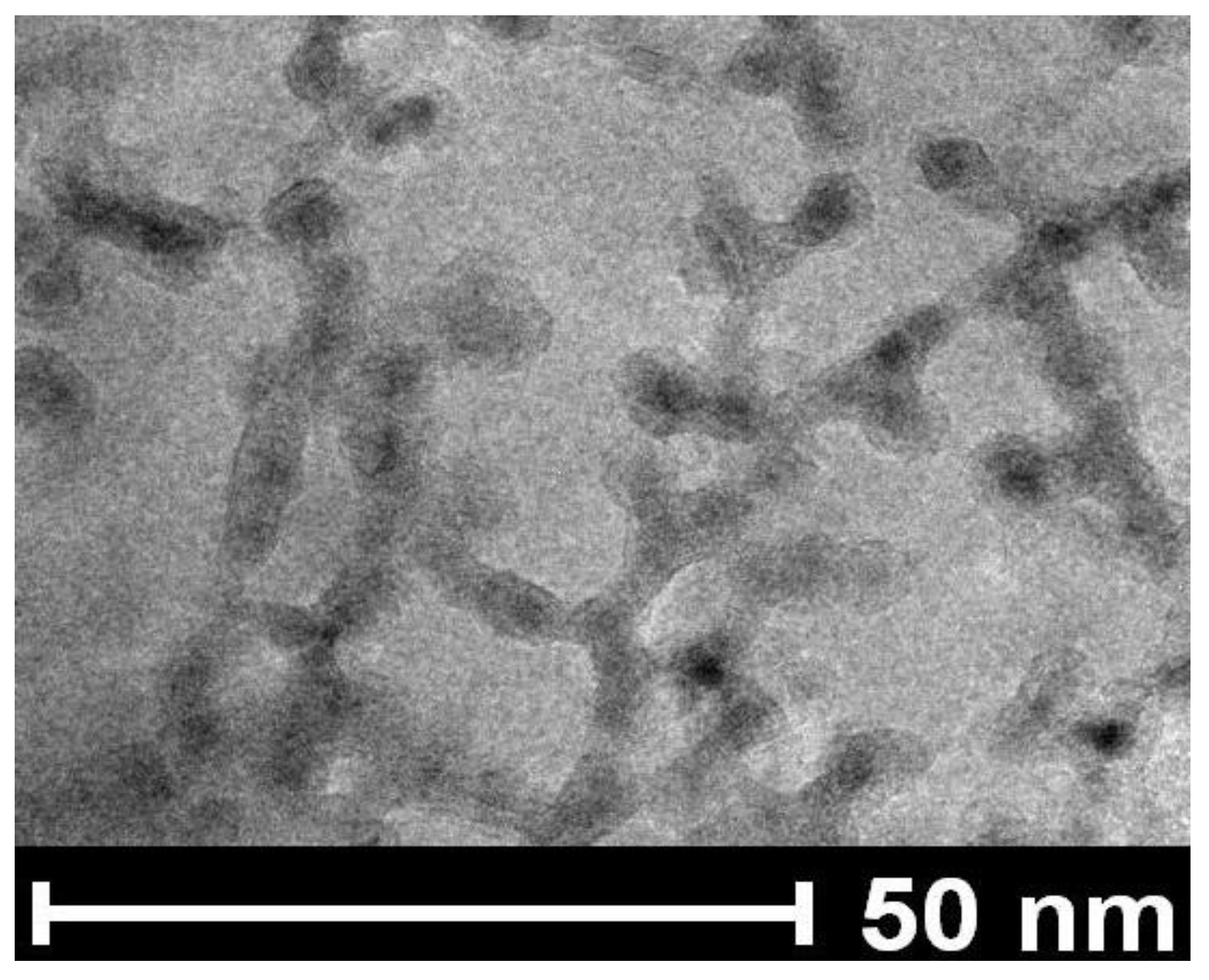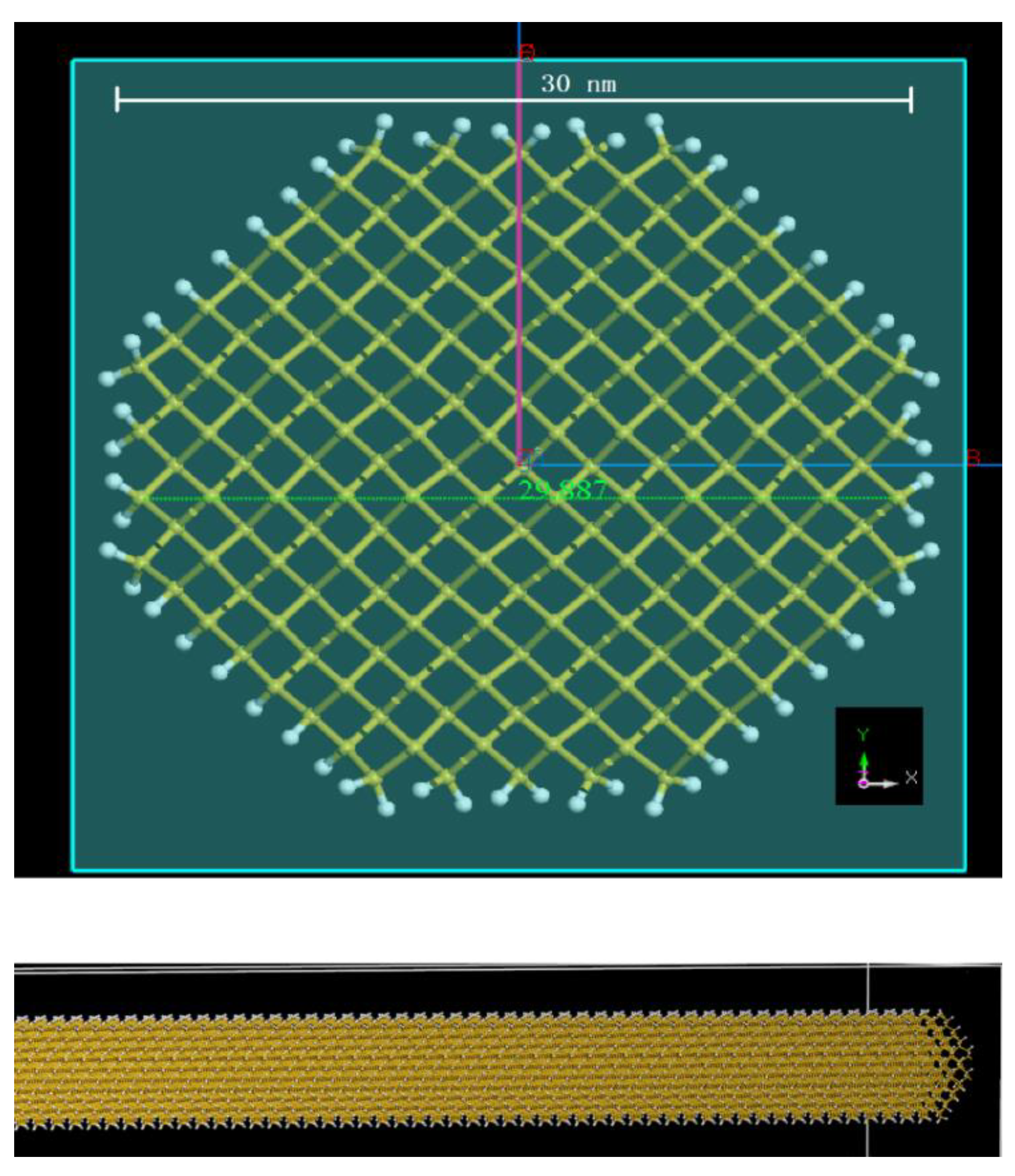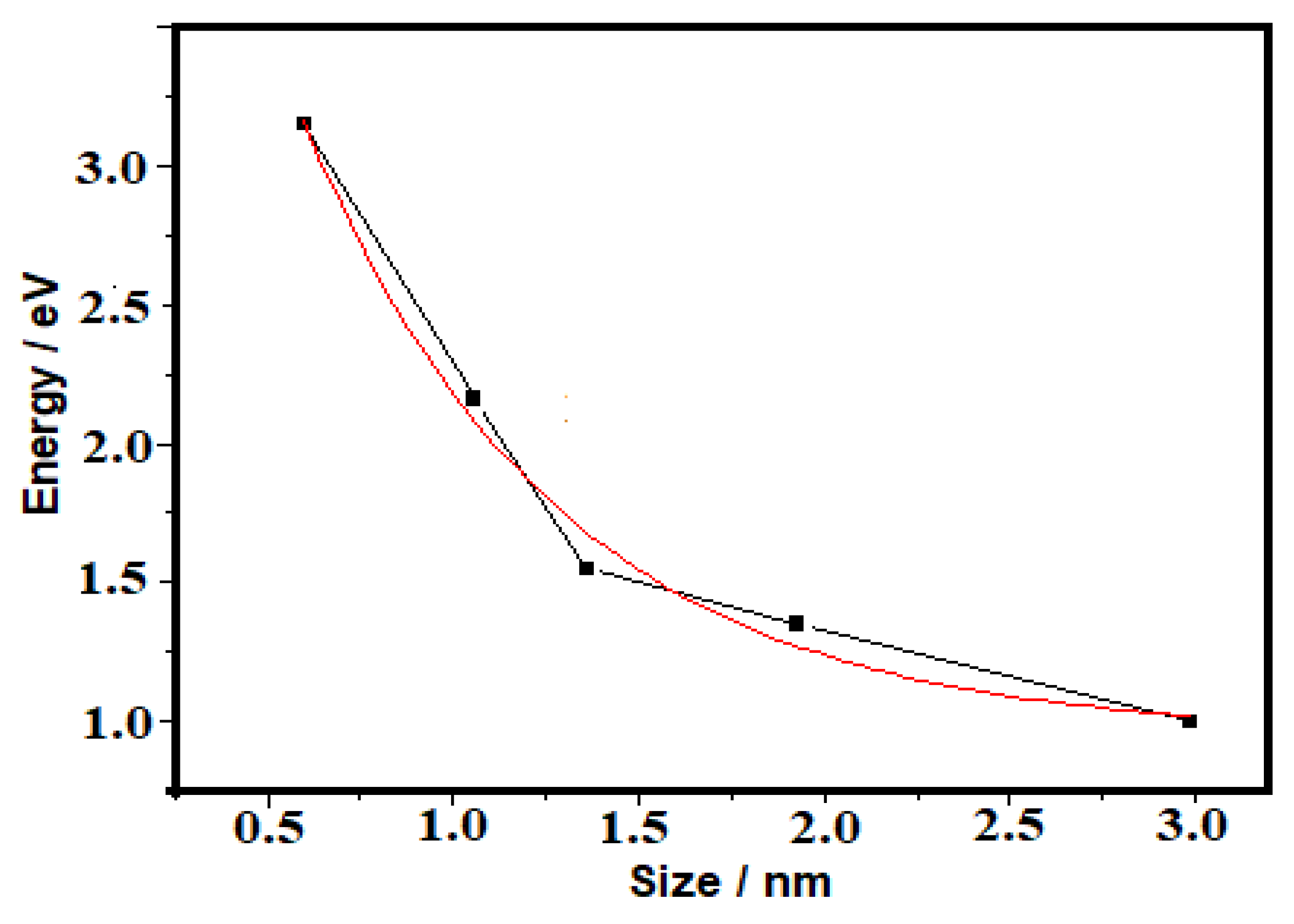Abrupt Change Effect of Bandgap Energy on Quantum System of Silicon Nanowire
Abstract
:1. Introduction
2. Fabrication of Silicon Nanowire
3. Investigation on Si NW in Simulation
4. The Abrupt Change Effect in Bandgap Energy
5. Methods
5.1. Preparation of Silicon Amorphous Nanofilm
5.2. Fabrication of Silicon NW Structure by Annealing
5.3. Transmission Electron Microscope (TEM) Analysis
6. Conclusions
Author Contributions
Funding
Conflicts of Interest
References
- Godefroo, S.; Hayne, M.; Jivanescu, M.; Stesmans, A.; Zacharias, M.; Lebedev, O.I.; Van Tendeloo, G.; Moshchalkov, V.V. Classification and control of the origin of photoluminescence from Si nanocrystals. Nat.Nanotechnol. 2008, 3, 174–178. [Google Scholar] [CrossRef] [PubMed] [Green Version]
- Daldosso, N.; Luppi, M.; Ossicini, S.; Degoli, E.; Magri, R.; Dalba, G.; Fornasini, P.; Grisenti, R.; Rocca, F.; Pavesi, L.; et al. Role of the interface region on the optoelectronic properties of silicon nanocrystals embedded in SiO2. Phys.Rev. B 2003, 68, 085327. [Google Scholar] [CrossRef] [Green Version]
- Wolkin, M.; Jorne, J.; Fauchet, P.; Allan, G.; Delerue, C. Electronic states and luminescence in porous silicon quantum dots: The role of oxygen. Phys. Rev. Lett. 1999, 82, 197–200. [Google Scholar] [CrossRef]
- Pavesi, L.; Turan, R. (Eds.) Silicon Nanocrystals; Fundamentals, Synthesis, and Applications; Wiley-VCH: Roma, Italia, 2010. [Google Scholar]
- Koshida, N. (Ed.) Nanostructure Science and Technology: Device Applications of Silicon Nanocrystals and Nanostructures; Springer: Berlin, Germany, 2008. [Google Scholar]
- Qian, F.; Gradecak, S.; Li, Y.; Wen, C.Y.; Lieber, C.M. Core/Multishell Nanowire Heterostructures as Multicolor, High-Efficiency Light-Emitting Diodes. Nano Lett. 2005, 5, 2287–2291. [Google Scholar] [CrossRef] [PubMed]
- Abadi, R.M.I.; Saremi, M. A Resonant Tunneling Nanowire Field Effect Transistor with Physical Contractions: A Negative Differential Resistance Device for Low Power Very Large Scale Integration Applications. J. Electron. Mater. 2018, 47, 1091–1098. [Google Scholar] [CrossRef]
- Tomioka, K.; Motohisa, J.; Hara, S.; Hiruma, K.; Fukui, T. GaAs/AlGaAs Core Multishell Nanowire-Based Light-Emitting Diodes on Si. Nano Lett. 2010, 10, 1639–1644. [Google Scholar] [CrossRef] [PubMed]
- Mayer, B.; Rudolph, D.; Schnell, J.; Mork€otter, S.; Winner, J.; Treu, J.; M€uller, K.; Bracher, G.; Abstreiter, G.; Koblm€uller, G.; et al. Lasing from individual GaAs-AlGaAs core-shell nanowires up to room temperature. Nat. Commun. 2013, 4, 2931. [Google Scholar] [CrossRef] [Green Version]
- Saxena, D.; Mokkapati, S.; Parkinson, P.; Jiang, N.; Gao, Q.; Tan, H.H.; Jagadish, C. Optically pumped room-temperature GaAs nanowire lasers. Nat. Photonics 2013, 7, 963–968. [Google Scholar] [CrossRef]
- Bryllert, T.; Wernersson, L.-E.; Froberg, L.E.; Samuelson, L. Vertical High-Mobility Wrap-Gated InAs Nanowire Transistor. IEEE Electron. Device Lett. 2006, 27, 323. [Google Scholar] [CrossRef]
- Tomioka, K.; Yoshimura, M.; Fukui, T. A III–V nanowire channel on silicon for high-performance vertical transistors. Nature 2012, 488, 189–192. [Google Scholar] [CrossRef]
- Wallentin, J.; Anttu, N.; Asoli, D.; Huffman, M.; Aberg, I.; Magnusson, M.H.; Siefer, G.; Fuss-Kailuweit, P.; Dimroth, F.; Witzigmann, B.; et al. InP Nanowire Array Solar Cells Achieving 13.8% Efficiency by Exceeding the Ray Optics Limit. Science 2013, 339, 1057–1060. [Google Scholar] [CrossRef] [Green Version]
- Okamoto, N.; Yanagisawa, R.; Anufriev, R.; MahfuzAlam, M.; Sawano, K.; Kurosawa, M.; Nomura, M. Semiballistic thermal conduction in polycrystalline SiGe nanowires. Appl. Phys. Lett. 2019, 115, 253101. [Google Scholar] [CrossRef]
- M€uller, M.; Bertram, F.; Veit, P.; Loitsch, B.; Winnerl, J.; Matich, S.; Finley, J.J.; Koblm€uller, G.; Christen, J. Nanoscale mapping of carrier recombination in GaAs/AlGaAs core-multishell nanowires by cathodoluminescence imaging in a scanning transmission electron microscope. Appl. Phys. Lett. 2019, 115, 243102. [Google Scholar] [CrossRef]
- Han, F.; Maloth, T.; Lubineau, G.; Yaldiz, R.; Tevtia, A. Computational Investigation of the morphology, efficiency, and properties of silver nano wires networks in transparent conductive film. Sci. Rep. 2018, 8, 17494. [Google Scholar] [CrossRef]
- Sun, Y.; Sun, B.; He, J.; Yang, G.; Wang, C. Millimeters long super flexible Mn5Si3@SiO2 electrical nanocables applicable in harsh environments. Nat.Commun. 2020, 11, 647. [Google Scholar] [CrossRef] [PubMed]
- Kanzawa, Y.; Kageyama, T.; Takeoka, S.; Fujii, M.; Hayashi, S.; Yamamoto, K. Size-dependent near-infrared photoluminescence spectra of Si nanocrystals embedded in SiO2 matrix. Solid State Commun. 1997, 7, 533–537. [Google Scholar] [CrossRef]
- Iacona, F.; Bongiorno, C.; Spinella, C.; Boninelli, S.; Priolo, F. Formation and evolution of luminescent Si nanoclusters produced by thermal annealing of SiOx films. J. Appl. Phys. 2004, 95, 3723. [Google Scholar] [CrossRef]
- Zacharias, M.; Heitmann, J.; Scholz, R.; Kahler, U.; Schmidt, M.; Bläsing, J. Size-controlled highly luminescent silicon nanocrystals: A SiO/SiO2 superlattice approach. Appl. Phys. Lett. 2002, 80, 661–663. [Google Scholar] [CrossRef]
- Liu, C.-Y.; Holman, Z.C.; Kortshagen, U.R.L. Optimization of Si NC/P3HT hybrid solar cells. Adv. Funct. Mater. 2010, 20, 2157–2164. [Google Scholar] [CrossRef]
- Mangolini, L.; Thimsen, E.; Kortshagen, U. High-yield plasma synthesis of luminescent silicon nanocrystals. Nano Lett. 2005, 5, 655–659. [Google Scholar] [CrossRef]
- Jurbergs, D.; Rogojina, E.; Mangolini, L.; Kortshagen, U. Silicon nanocrystals with ensemble quantum yields exceeding 60%. Appl. Phys. Lett. 2006, 88, 233116. [Google Scholar] [CrossRef]
- Gupta, A.; Swihart, M.T.; Wiggers, H. Luminescent colloidal dispersion of silicon quantum dots from microwave plasma synthesis: Exploring the photoluminescence behavior across the visible spectrum. Adv. Funct. Mater. 2009, 19, 696–703. [Google Scholar] [CrossRef]
- Niesar, S.; Pereira, R.N.; Stegner, A.R.; Erhard, N.; Hoeb, M.; Baumer, A.; Wiggers, H.; Brandt, M.H.; Stutzmann, M. Low-cost post-growth treatments of crystalline silicon nanoparticles improving surface and electronic properties. Adv. Funct. Mater. 2012, 22, 1190–1198. [Google Scholar] [CrossRef]
- Alima, D.; Estrin, Y.; Rich, D.H.; Bar, I. The structural and optical properties of supercontinuum emitting Si nanocrystals prepared by laser ablation in water. J. Appl. Phys. 2012, 112, 114312. [Google Scholar] [CrossRef] [Green Version]
- Crouch, C.H.; Carey, J.E.; Warrender, J.M.; Aziz, M.J.; Mazur, E.; Génin, F.Y. Comparision of structure and properties of femtosecond and nanosecond laser-structured silicon. Appl. Phys. Lett. 2004, 84, 1850–1852. [Google Scholar] [CrossRef]
- Huang, W.Q.; Liu, S.R.; Huang, Z.M.; Dong, T.G.; Wang, G.; Qin, C.J. Magic electron affection in preparation process of silicon nanocrystal. Sci. Rep. 2015, 4, 9932. [Google Scholar] [CrossRef] [PubMed] [Green Version]
- Huang, W.Q.; Wu, X.K.; Liu, S.R.; Qin, C.J. Curved surface effect and manipulation of electronic states in nanosilicon. Sci. Rep. 2017, 7, 17974. [Google Scholar] [CrossRef]








© 2020 by the authors. Licensee MDPI, Basel, Switzerland. This article is an open access article distributed under the terms and conditions of the Creative Commons Attribution (CC BY) license (http://creativecommons.org/licenses/by/4.0/).
Share and Cite
Huang, Z.-M.; Liu, S.-R.; Peng, H.-Y.; Li, X.; Huang, W.-Q. Abrupt Change Effect of Bandgap Energy on Quantum System of Silicon Nanowire. Crystals 2020, 10, 340. https://doi.org/10.3390/cryst10050340
Huang Z-M, Liu S-R, Peng H-Y, Li X, Huang W-Q. Abrupt Change Effect of Bandgap Energy on Quantum System of Silicon Nanowire. Crystals. 2020; 10(5):340. https://doi.org/10.3390/cryst10050340
Chicago/Turabian StyleHuang, Zhong-Mei, Shi-Rong Liu, Hong-Yan Peng, Xin Li, and Wei-Qi Huang. 2020. "Abrupt Change Effect of Bandgap Energy on Quantum System of Silicon Nanowire" Crystals 10, no. 5: 340. https://doi.org/10.3390/cryst10050340
APA StyleHuang, Z.-M., Liu, S.-R., Peng, H.-Y., Li, X., & Huang, W.-Q. (2020). Abrupt Change Effect of Bandgap Energy on Quantum System of Silicon Nanowire. Crystals, 10(5), 340. https://doi.org/10.3390/cryst10050340



